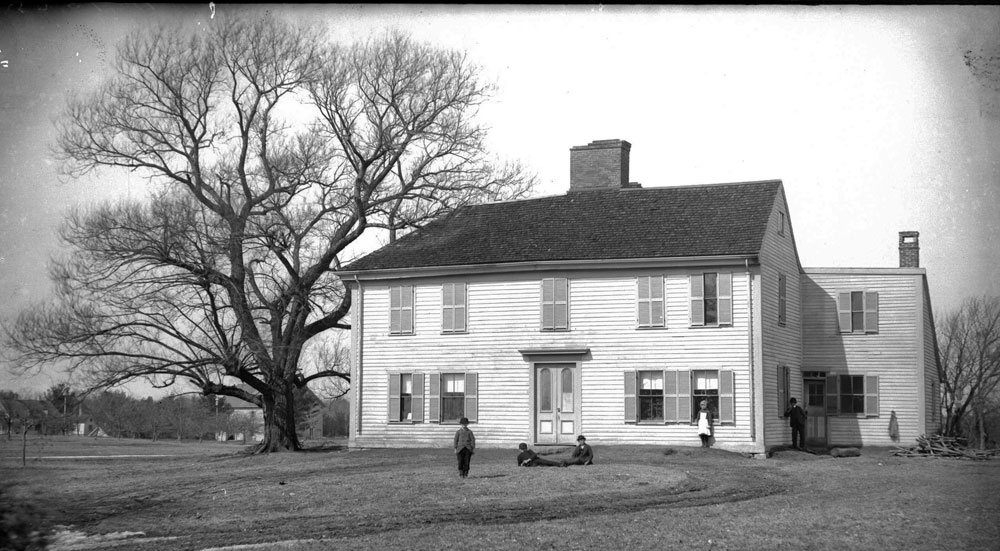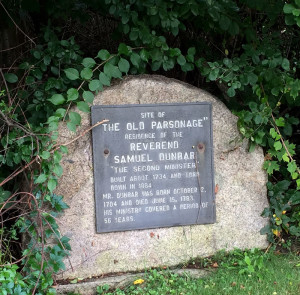True Tales from Canton’s Past: The Old Manse
By George T. Comeau
The Old Manse stood on Chapman St. for 150 years until it was demolished in 1884. (Courtesy of the Canton Historical Society)
The house you live in today is likely an unremarkable dwelling. Built by a general contractor, suited for 21st century living. Our houses today are not especially special and in 100 years many of them will have been replaced by whatever is the fashion of that day. This is not a happy or sad statement; it is just that our housing stock is not all that special. When historians catalogue the houses and look back upon today, what will be extraordinary? What will be worthy of saving for another generation?
Extraordinary homes are hardly ever built today. We live in a society of ever-increasing consumer-driven acquisition. Three-car garages burst at the seams with the stuff we have bought. Our basements are crammed with the detritus of a modern life. Three bedrooms, four baths, with kitchens maxed out on electrical appliances. Look around you — how much is your house a reflection of you and your place in Canton?
In 1884, on the north side of Chapman Street, a remarkable home ended its place in our history. The house was known as the Old Manse, named because at one point it was simply the Manse. A clergy house, manses were common in England, Scotland, and in New England — wherever the Presbyterian or Unitarian churches had their home. Once the clergyman died, the house would become known as “the old manse.” In Canton, the old manse was built and became the home to our greatest historical figure, the Reverend Samuel Dunbar. On land that was purchased from the Ponkapoag Indians, Dunbar purchased a house and within a few years demolished it to build his new home in what was then Stoughton.
Historians tell us that it was built in the fashion of the 18th century: two stories in front, sloping gradually almost to the ground in the rear, a lean-to roof. The front door was topped with fanciful woodwork culminating in a Greek delta. From the roof, two enormous chimneys reached skyward, made from bricks procured from the nearby Pecunit Meadows. A chaise house stood next door, and until 1809, the town’s supply of gunpowder and ammunition was stored here.
This was a grand house. In the front yard stood a mulberry tree that lived into the late 1800s — even longer than the house stood. When it was built, the manse on Chapman Street was the “handsomest house between Boston and Providence.” An observer of the day wrote, “Entering the old manse, the visitor was struck by the quaint appearance of the rooms; the old beams finished with wood, protruded through the ceiling, and one could easily reach them by raising the arm. The panels of the doors were immense, and at the back of one of the closets is a sliding door; by pushing up the slide, a recess is revealed; this is the place where the former occupants kept their favorite liquor.”
Even more than the architecture, it was the historical associations that made this building an amazing part of our history. Parson Dunbar, as he was known, was the second minister in this town. Newly minted from Harvard University, Dunbar would leave an indelible mark on Stoughton and subsequently Canton through his firm and unflinching courageousness. To see this man was to see the perfect 18th century man at the height of fashion and dignity. Catching a glimpse, you would see a long black gown, snow-white bands, flowing gray wig, black short-clothes fitted with knee and completed with bright shoe buckles. Yet this man was indeed larger than life. For 55 years Dunbar tended to his flock. In times of trouble — and there were plenty — Dunbar ministered actively in support of the souls in his charge.
If the house was a reflection of the man, it is such that this was a true New England soul in both the frame and in the bones. As war broke out with England, Dunbar was the first to provide prayers in 1774 at the Doty Tavern at the drafting of the Suffolk Resolves. This was the true start of the American Revolution, and Dunbar stood shoulder to shoulder with true patriots as a draft resolution was written. “Whereas it appears to us that the Parliament of Great Britain to the Dishonor of the King, in Violation of the faith of the Nation Have in Direct infraction of the Charter of this Province Contrary to Magna Charta the Bill of Rights … Attempted to Prejudice this Colony to an unparalleled State of Slavery, and Whereas the Several Colonies Being Justly and Properly Alarmed with this Lawless & Tyranical Exertion of Power has Entered into Combination for our Relief.”
Merely uttering, let alone writing such words meant death. Dunbar’s son, Elijah, did not immediately side with the Patriots, yet the father brought sense to the dialogue and within months the two Dunbars were a formidable force for liberty. It was at the manse that politics were debated upon the birth of a new nation. One of the more frequent visitors was Daniel Leonard, a member of a prominent family that had made a fortune in the Iron Works at Taunton. During the Revolutionary crisis, the British Parliament passed the Massachusetts Government Act, which, among other things, abolished elections for the Massachusetts Governor’s Council and instead called for the councilors to be appointed by the royal governor. Leonard accepted an appointment by Governor Thomas Hutchinson to this new royal-controlled council.

Today, an almost hidden stone marker memorializes the spot near the Old Manse. (Photo by the author)
Frequently, when traveling to Boston from Taunton, Leonard could be seen in splendor visiting his college friend Dunbar in Canton. The scene as described by John Adams is particularly vivid. “He drives up with a chariot and pair, upon his head he wore a three-cornered hat, around which was a broad band of gold lace; his cloak glittered with lace still broader and flunkies in livery were perched on box and rumble, who alighted at his slightest word.” The man himself, when apart from the trappings of wealth and crown, was wonderfully attractive, a man of the most brilliant intellect, but a notorious conspirator, a scholar, a lawyer, an orator, and the author of an amazing series of letters that fanned the flames of the American Revolution.
In 1774 and 1775, Leonard, writing under the name “Massachusettensis,” wrote a series of letters in support of royal government that were published in a Loyalist Boston newspaper, the Massachusetts Gazette. John Adams, writing as “Novanglus,” answered the letters in the Boston Gazette. The exchange ceased with the Battles of Lexington and Concord. Imagine the conversations that took place in that house on Chapman Street on the eve of the Revolution in America.
Ultimately, Dunbar — both father and son — parted ways with Leonard, who left with the British when they evacuated Boston in 1776. Leonard’s property, like that of other Loyalists, was confiscated. Ultimately exiled from Massachusetts, he served as chief justice of Bermuda from 1782 to 1806 and later retired to London, where it is supposed that he committed suicide in 1829.
The old manse was a silent witness to history, and within its walls some of the true founding fathers gathered to promote the cause that we live by today. Most poignantly is the fact that the builder, Parson Samuel Dunbar, lived largely his entire life in this house and would die in the very house he built. This was the man that had fought for and ultimately against the King of England. Dunbar rallied the community around the fire of freedom, and in his final days his gaze was long and steady.
Local historian Daniel Huntoon wrote the most beautiful words when he reflected on the loss of that old house and what it meant for Dunbar to die there. “Finally, time’s vision ended; he turns him toward the setting sun, and sees the twilight of the evening gather into night. He casts one glance down the long past; he beholds, as in a dream, scenes, persons, transactions that had vanished years ago; through the glass of memory, his early ministry appears before him; forms long forgotten rise in preternatural distinctness, and snatches of life’s early melody thrill through his ears. Death comes to him, and proves, I trust the gate to life everlasting, to glory and happiness eternal. The weeping friends assemble in the old manse and tenderly bear him from its portals to the ancient churchyard.”
Eight thousand sermons had been written under the roof of the old manse. The earliest library in Canton started within these walls, and it included the best-selected and most valuable collection of early music in America. In fact, it was Dunbar’s son Elijah who formed the first (and still today the oldest) choral society in America. Music reverberated through the house, children played on the lawn, politics was discussed, and seasons changed. Yet, like the man, this house made with his hands too would pass into another realm.
After the demolition of the Old Manse on March 18, 1884, the following poem was published in the Boston Evening Transcript in tribute through the words of Longfellow: “We may build more splendid habitations, fill our rooms with paintings and with sculptures, but we cannot buy with gold the old associations.”
Today, a historic marker behind the wall at 87 Chapman Street marks the corner of the property of the Old Manse. The splendid house that replaced it is owned by one of the current Canton selectman, and someday too, this house will likely be replaced. The history of that land is forever sacred to the memory of Samuel Dunbar and the role he played in the founding of the United States of America.
Short URL: https://www.thecantoncitizen.com/?p=30771










